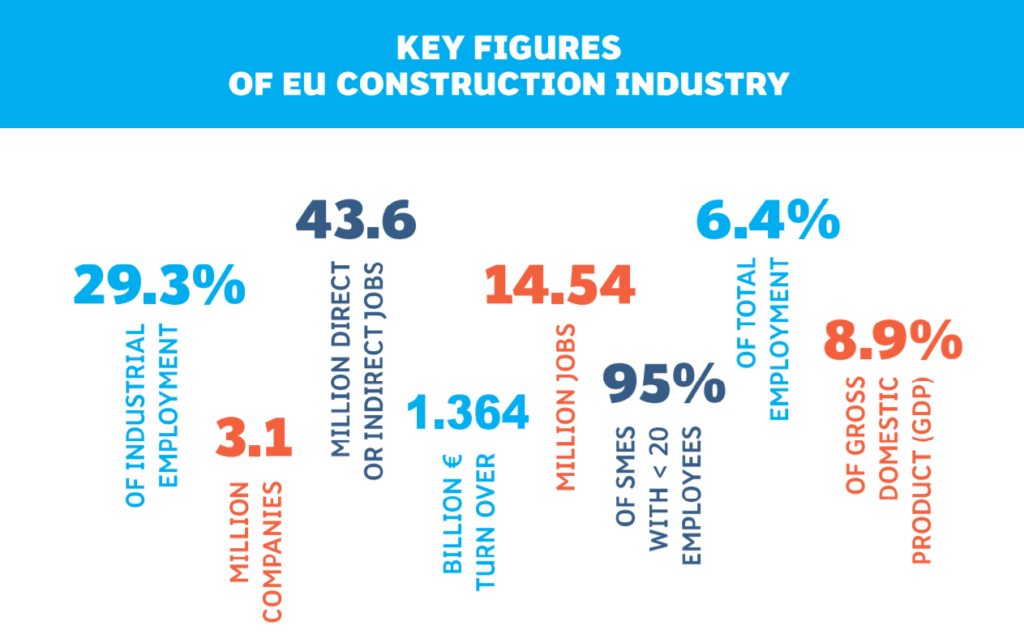A few months ago the European Construction Industry Federation (FIEC) in collaboration with other leading European construction associations published the European Construction Industry Manifesto for digitalisation.
The manifesto focuses on the numerous actions that EU could take in order to facilitate the digital transformation of the construction industry. The optimisation of the current data policy framework and the budget increase in areas such as digital infrastructure and R&D are some of the main points.
![]()
It is no exaggeration to say that the publishing of the manifesto comes at an excellent timing. The entire EU economy is under great pressure in its effort to adjust in the new digital world and construction is, of course, an area of great investment opportunity.

Now more than ever, a digital transformation of the construction value chain is deemed as a necessity in the effort to build an inclusive and cost-efficient sector.
What makes construction even more special is the fact that its development has a direct impact on many different financial sectors which in one way or another are part of the supply chain. Machinery and product manufacturing, infrastructure, and real estate are just a few examples.
The importance of the construction industry is also reflected in its integral presence in other parts of the EU economy: energy efficiency, job market, demographic alterations, environmental issues, data protection, and education.
According to the manifesto, digitalisation should be seen as the medium through which many different aspects of the industry can be decisively improved. More specifically, it can play a significant role in boosting productivity, minimising delays and rework rates, while also improving safety and accelerating the building lifecycle.
In other words, digitalisation isn’t the final destination for the industry but the tool for achieving the goals set both by European construction and the European Union.
However, construction companies can’t proceed with this substantial paradigm shift without the support of the EU through regulatory action and R&D investment.
Good news is that the construction sector has already embarked on the digitalisation journey and is on the verge of a revolutionary change. This is gradually achieved through the increase of digital maturity and the adoption of new digital tools and processes.
BIM, Artificial Intelligence and Big Data are only a few areas with great potential for the industry. Especially when we refer to data, we are talking about the most valuable resource for the future of the sector as it can be the foundation on which all the digital initiatives of the sector can be based on.
And that’s why data ownership is considered extremely important. European construction stakeholders should be able to open up the building process and create a digital ecosystem which will knowledge and expertise sharing across projects, sectors and even borders.
European construction in numbers
In an effort to visualise how crucial the part of European construction is in EU, it is a good idea to take a closer look at the following statistics as presented at the European Construction Industry Manifesto for digitalisation:

As illustrated in the graph above, the construction industry represents 6.4% of the total employment within the European Union, and the number of construction companies is approximately 3.1 million.
What is more, 29.3% of the EU industrial employment is connected to construction. This number is no surprise if we take into account that there are 43.6 million jobs which are related to construction either in a direct or an indirect manner.
Lastly, the fact that European construction covers 8.9% of the gross domestic product (GDP) with a turnover of €1.364 billion proves the gravity of the sector for the entire EU economy.
How the European Union can help the sector
The European Construction Industry Manifesto for digitalisation goes one step further and analyses in detail the actions that EU should take in order to prioritise the digitalisation of the construction industry.
In a nutshell, here are the three main steps that the European Union should take with regards to the digital shift of the building sector:
1. EU should lead construction to digital transformation
All EU organisations and institutions have to adopt a strong political stand when it comes to the digital transformation of the construction industry. Based on the manifesto, it becomes clear that construction should be placed in the center of attention when EU initiatives (eg. ‘Digitising European Industry’) are introduced.
EU has the political responsibility to pave the way for a smooth transition to a more digitised era for the industry. This could be achieved through the launch of a flexible cultural governance which prioritises open IT ecosystems that promote Research and Development.
Like that, the construction industry in close collaboration with academia will have the valuable opportunity of delivering R&D programmes which focus on the needs of the market.
2. A detailed regulatory framework is required
The advent of digitalisation is rapidly changing the way the entire world is regulating around the data. GDPR is the last example of such endeavors and concentrates on the protection of personal data.
As described in the manifesto, EU associations should step up their regulatory game in terms of data policies in construction, as well. A carefully elaborated regulatory framework can make a big difference concerning the quality and the management of the data.
Read also: 10 tips for delivering construction projects on time and on budget
In addition, it can resolve any security or intellectual property issues and clarify which party is responsible for which part of the data. Simply put, it can protect the sector from data monopolies which can make it difficult for the sector to collaborate and thrive.
After all, the establishment of well-regulated data environment can allow many different digital players in construction to come together and create a more democratised field for digital technologies to emerge and develop further.
3. More financial support R&D and IT infrastructure
EU budget is the third pillar of the European Construction Industry Manifesto for digitalisation. Despite the big efforts of the sector to embrace digital transformation and introduce new revolutionary techniques to the field, the initial financial risk holds such initiatives back in many cases. As a result, the digitalisation of the sector is seriously hindered.
Taking these observations into account, the manifesto suggests that the 2020 Multiannual Financial Framework should focus on the points presented below:
- Digital skills: The assessment and identification of the skills needed in digital construction can be the first step for improving the training level in the sector, evolving the current workers and attracting fresh talent in the industry.
- Research and Development: To empower innovation in the sector and create the right conditions for new strategic partnerships to be established.
- IT infrastructure: Internet infrastructure is also a substantial aspect for the digitalisation of the sector. The investment in cost-efficient high-speed internet will surely make a difference in the long run.
Final word
All in all, the European Construction Industry Manifesto for digitalisation explains in a very straightforward way the need for prioritising the digital transformation of a sector with so great impact on almost every aspect of the public life.
Digital solutions can play a paramount role in the industry’s future but the most important factor we should keep in mind is that it will unlock a whole new level of collaboration for the entire sector.
The digital journey of the sector has just begun and its success is largely depended on the quality of communication between the numerous stakeholders. This is where EU associations should show their support and help innovative players of construction to explore the potential of unknown digital territories.
LetsBuild will once again be on board on this journey. We believe in a construction industry where people should work smarter not harder. And this is what we try to achieve through our real-time collaboration software.




